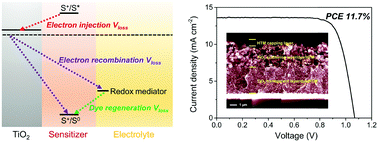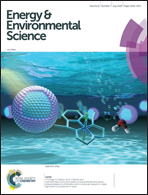Comprehensive control of voltage loss enables 11.7% efficient solid-state dye-sensitized solar cells†
Abstract
The relatively large voltage loss (Vloss) in excitonic type solar cells severely limits their power conversion efficiencies (PCEs). Here, we report a comprehensive control of Vloss through efficacious engineering of the sensitizer and redox mediator, making a breakthrough in the PCE of dye-sensitized solar cells (DSSCs). The targeted down-regulation of Vloss is successfully realized by three valid channels: (i) reducing the driving force of electron injection through dye molecular engineering, (ii) decreasing the dye regeneration overpotential through redox mediator engineering, and (iii) suppressing interfacial electron recombination. Significantly, the “trade-off” effect between the dye optical band gap and the open-circuit voltage (VOC) is minimized to a great extent, achieving a distinct enhancement in photovoltaic performance (PCE > 11.5% with VOC up to 1.1 V) for liquid junction cells. The solidification of the best-performing device leads to a PCE of 11.7%, which is so far the highest efficiency obtained for solid-state DSSCs. Our work inspires further development in highly efficient excitonic solar cells by comprehensive control of Vloss.

- This article is part of the themed collection: 2018 Energy and Environmental Science HOT Articles


 Please wait while we load your content...
Please wait while we load your content...